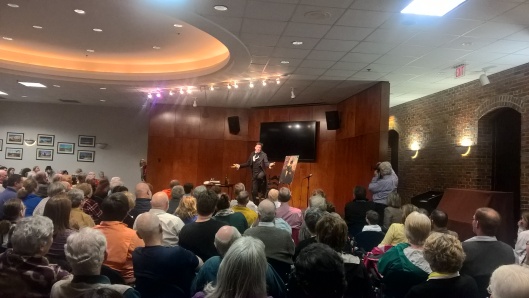
Posted by Twistification | Filed under Uncategorized
08 Wednesday Jan 2020
18 Wednesday Dec 2019
Posted in Uncategorized
I’ve recently gotten into historical tabletop gaming and miniature painting. Started a campaign based on Road to Guilford Courthouse by John Buchanan. Using the Sharp Practice rules. Updates via Evernote here:
Southern Campaign Scenario 1: Augusta Diversion
05 Wednesday Jun 2019
Posted in Uncategorized
 Michael Logusz’ With Musket & Tomahawk is a fascinating read that covers Burgoynes’ ill fated wilderness campaign during the early part of the American Revolution.
Michael Logusz’ With Musket & Tomahawk is a fascinating read that covers Burgoynes’ ill fated wilderness campaign during the early part of the American Revolution.
Two overarching themes struck me as I read the book. One is histories consistent yet rarely heeded reminder that no matter how well intentioned an invading force may be, it is still an invading force. The second is the innovations of 18th century warfare brought about by the influence of geography and the native Americans.
Observations

After reading this book I find myself often shaking my head at politicians and military authorities assumptions around invading foreign soil. No doubt history has its many lessons to teach, but do we really want to listen? Or are we confident that THIS time the situation and outcome will be different?
02 Tuesday Apr 2019
Posted in Uncategorized
 Struck up an old hobby of mine…this blog will take a tabletop slant….
Struck up an old hobby of mine…this blog will take a tabletop slant….
20 Thursday Apr 2017
Posted in Uncategorized
Almost done, but good enough for Brattonsville. Came in handy too. Learned (through repeated trial and error) the back stitch, cross stitch, hem stitch. Pretty therapeutic honestly, when you don’t count the aggravation of realizing you stitched 3 foot of cloth the wrong way…

I’ve taken the dive into hand sewing a hunting frock. I’m a newbie at every essential part of this process (even down to watching how to YouTube videos for stitching basics). With the help of Luis Cruz of the 6th North Carolina, I hope to get at least something minimally useful.
My achilles heel in projects like this is my patience. Once I begin to rush, attention to detail goes out the window and things go down hill. Patience is my ally.
I listen to the radio while I work in my musket room. Normally talk radio or the perpetually mediocre Atlanta Hawks play by play of Steve Holman. Holman is probably the closest homer we’ve had in Atlanta sports since the passing of Larry Munson–except with Munson insurmountable obstacle was always the opponent–“did you see the SIZE of those guys??” For Holman, its normally the refs–“I can’t believe they did/did not make that CALL!!”. I give Holman credit, he makes even the Atlanta fan’s familiar pang of disappointment somewhat entertaining. 
08 Wednesday Mar 2017
Posted in Gear
This is great:
https://allthingsliberty.com/shop/
I’ll take it all. Thanks!
I haven’t checked out all things liberty lately. They reached out to me a few years ago asking if I were interested in providing some content, however my interest in the period does not extent past ‘enthusiast’, and the time simply wasn’t there to do some deep dive research. But I appreciate them reaching out.
Speaking of online, I recently came across a flintlock enthusiast page in Facebook. That looks like a lot of fun.
https://www.facebook.com/groups/1683675588580468/
07 Tuesday Feb 2017
Posted in Uncategorized
The annual celebration for the battle of Cowpens is my favorite annual pilgrimage. Its always a good time driving up the night before, attending an evening event, then walking the grounds Saturday morning.
 Ken Johnson will portrayed Lieutenant Colonel Banastre Tarleton, British commander at the Battle of Cowpens that Saturday night at a local library. It was a packed room and Ken took an interesting approach as he portrayed Tarleton as a member of Parliament, looking back on his days in America. Lively, fun and often hilarious, Ken answered questions and traded barbs with the packed house.
Ken Johnson will portrayed Lieutenant Colonel Banastre Tarleton, British commander at the Battle of Cowpens that Saturday night at a local library. It was a packed room and Ken took an interesting approach as he portrayed Tarleton as a member of Parliament, looking back on his days in America. Lively, fun and often hilarious, Ken answered questions and traded barbs with the packed house.
The last few years, we’ve had some good luck with weather. This year was a little overcast, but not too bad for a January. I met with some members of the 6th North Carolina and walked the grounds again that Saturday.

“Blucher!! I can’t chase down your men!”
My favorite demonstration at Cowpens has to be the cavalry. The talks are enlightening, and I learn something new every year. 18th century warfare is a diverse and specialized affair, and cavalry provide a critical tool in the lines of any army. Essential tasks include scouting, protecting infantry and cannon, and chasing down fleeing troops. I remember reading that Napoleons loss of horses in Russia was perhaps more devastating than the loss of men. After that, Napoleon was never able to capitalize on his victories by chasing down and removing the defeated armies with cavalry. They simply regrouped and came back again.
Will follow up with another post about what I have learned about Cavalry.
14 Friday Oct 2016
Posted in Uncategorized
In an effort to improve my irritable state of mind these past few weeks, I’ve made an effort to avoid political news (and my Facebook feed for that matter). I came across this neat site called ‘Vintage News‘. If you want to burn a few hours clicking around, I highly recommend.
Check out these wonderful photos of the Native Americans at the Crow reservation. Truly a glimpse into a world passing buy. I have a few images here that I’ve touched up in Photoshop, but definitely take the time to check out the collection.
I’ve been meaning to look more deeply into Native Americans in the 18th century ever since reading Charles C. Mann’s ‘fantastic book ‘1491’. So so much I don’t know.
11 Sunday Sep 2016
Posted in reenactment, Uncategorized
My second reenactment is in the books. I had a great time. Thanks to Louis and the 6th North Carolina for the outfitting, great food and fun battles. Now on to some observations:
Overall the weekend was a success. Next up is Camden (as a participant) and then Cowpens (as an observer). And now for a few photos. I still would love to find some action shots of the battles.
02 Friday Sep 2016
Posted in Uncategorized
This weekend I’ll be heading up to Charlotte for a reenactment. Its been a few years since The Battle of the Hook,(1) (2) ,(3),(4) and since then I’ve been planning on attending another once I spotted the rare and fleeting opening in my family schedule. This time around, I set about requisitioning some custom made trousers, a frock and a few other nick knacks. Hope to complete the outfitting with loaners once I am there.
McIntyre’s Farm was the location of a skirmish called ‘Battle of the Bees’ where a foraging party under Cornwallis was surprised and beaten back by local militia. Not exactly a glamours battle, but any excuse to do a little camping and discharge my musket will do! The location of the event is Latta Plantation. Looks nice there. I’ll try and take some photos.
Bloviation for the Dawgnation
Experiences in Life & Kitchen
Has "TURN: Washington's Spies" left you feeling a little... spy-curious?
4 out of 5 dentists are pulling for me!
in 2002 I decided to share my weight loss journey! Its been a life struggle. I hope this site helps others who deal with emotional eating!
the Story within the Story
All Things Revolutionary War
Clearly, I take myself seriously.
Blogging American History--News, Books, Museums, Sites, and More
Historian. Artist. Gunmaker.
All Things Revolutionary War
Discussions about the American Civil War (1861-1865)